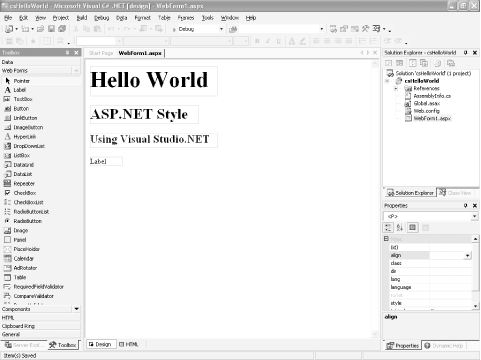The Integrated Development Environment (IDE)
The Visual Studio .NET integrated development environment (IDE) consists of windows for visual design of forms, code-editing windows, menus and toolbars providing access to commands and features, toolboxes containing controls for use on the forms, and windows providing properties and information about forms, controls, projects, and the solution.
Layout
Visual Studio .NET is a multiple document interface (MDI) application. It consists of a single parent window, which contains multiple windows. All the menus, toolbars, design and editing windows, and miscellaneous other windows are associated with the single parent window.
A typical layout of the IDE is shown in Figure 2-3. This section discusses the overall layout and many of the features that make working with the IDE so productive.

Figure 2-3. Typical IDE layout
The Visual Studio .NET window has a title bar across the top with menus below. Under the menus are toolbars with buttons that duplicate many of the common menu commands. Nearly everything that can be done through menus can also be done with context-sensitive pop-up menus, as described in the discussion that follows. The menu and toolbars are easily customized by clicking on Tools → Customize.
The toolbars are docked along the top of the window by default. As with many Windows applications, they can be undocked and moved to other locations, ...
Get Programming ASP.NET, Second Edition now with the O’Reilly learning platform.
O’Reilly members experience books, live events, courses curated by job role, and more from O’Reilly and nearly 200 top publishers.

